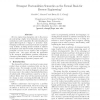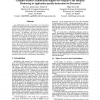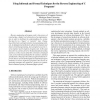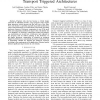WCRE
1995
IEEE
14 years 6 months ago
1995
IEEE
Reverse engineering of program code is the process of constructing a higher level abstraction of an implementation in order to facilitate the understanding of a system that may be...
ICCD
2007
IEEE
14 years 7 months ago
2007
IEEE
As application-specific instruction set processors (ASIPs) are being increasingly used in mobile embedded systems, the ubiquitous networking connections have exposed these systems...
ICSM
1996
IEEE
14 years 7 months ago
1996
IEEE
Reverse engineering of program code is the process of constructing a higher level abstraction of an implementation in order to facilitate the understanding of a system that may be...
CCS
2001
ACM
14 years 7 months ago
2001
ACM
Abstract. Protection of software code against illegitimate modifications by its users is a pressing issue to many software developers. Many software-based mechanisms for protectin...
SSS
2005
Springer
14 years 8 months ago
2005
Springer
Dijkstra’s concept of self-stabilization assumes that faults can only affect the variables of a program. We study the notion of selfstabilization if faults can also affect (i.e...
ISCAS
2005
IEEE
14 years 8 months ago
2005
IEEE
— Program code size has become a critical design constraint of embedded systems. Large program codes require large memories, which increase the size and cost of the chip. Poor co...
IEEEPACT
2007
IEEE
14 years 9 months ago
2007
IEEE
The use of multi-core, multi-processor machines is opening new opportunities for software speculation, where program code is speculatively executed to improve performance at the a...




